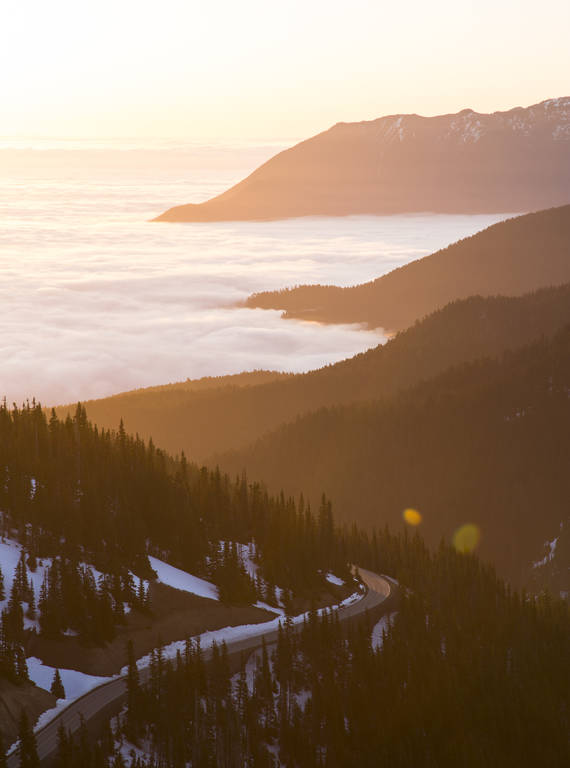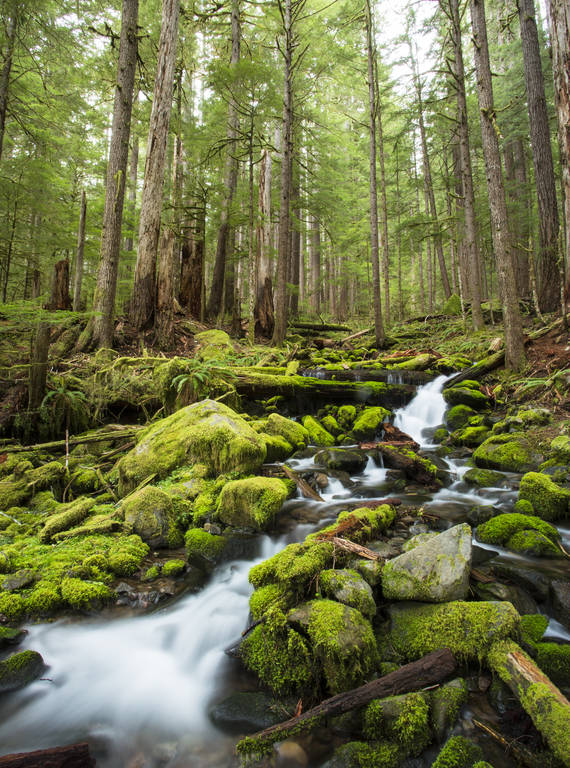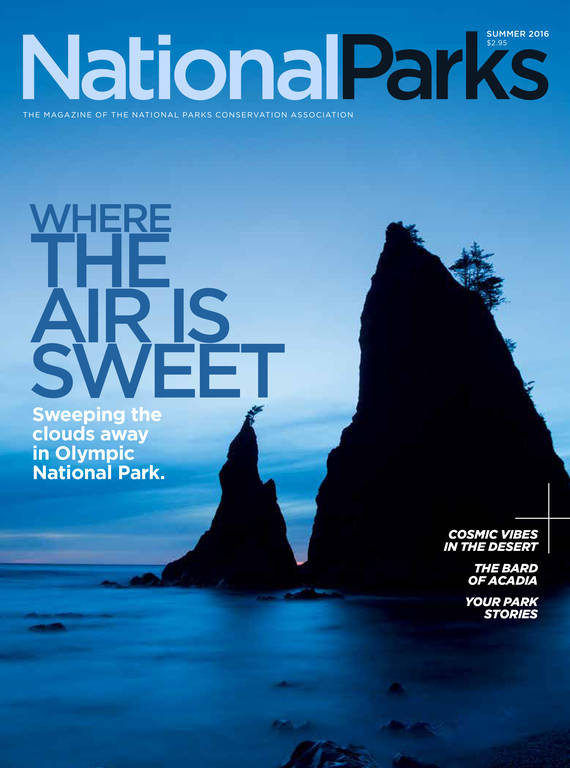Summer 2016
Sunny Days
Everything’s A-OK when sunshine lights up the coastline, mountains and rainforest of Olympic National Park.
I always travel with pen and paper, but on a recent trip to Olympic National Park, I fell into the habit of talking into my phone when it wasn’t convenient to take notes. I didn’t have a chance to listen to my voice memos right away, but one morning, several days after my return, I slipped on some headphones at work and hit play.
NPCA@WORK
“Oh my God!” I had shout-whispered in a recording I’d made while standing on Rialto Beach. I’d just spotted a trio of river otters scampering across the sand. “They are so cute! It looks like a day at the beach for them! They’re just tumbling around! They’re riding the waves and the seagulls are lined up watching. Here they come! Oh my goodness!”
I’m above-average excitable, sure, but back at my desk, back in the real world of to-do lists and carpools, my ravings just made me laugh. It reminded me of the viral rainbow video that made the rounds a few years ago. A guy in California filmed a double rainbow and spent three and half minutes laughing and crying and exclaiming about how vivid and beautiful and intense it was. “What does it mean?” he exulted. More than 43 million people watched the YouTube video; I was not the only one who chuckled and wondered what this fellow had consumed before his exuberant monologue.
Then I heard myself ranting, and suddenly, I didn’t feel so smugly superior. Whoa, as the double rainbow guy would say. What exactly had happened to me in Olympic?
Well: not much but a lot. The sun shone and the park sparkled. I watched the sky awaken at dawn and darken at dusk. I visited three ecosystems and hiked and kayaked. It was totally ordinary and mind-blowing.
I almost hadn’t gone. I’d thrown the trip together at the last minute, worried the whole time about bad weather and a possible government shutdown closing the park. Ragged and frazzled, I wondered whether I was making a mistake, given the timing and my responsibilities at home. And then I was utterly dazzled from the moment my adventure started at precisely 4:30 a.m. on a cold fall morning.
Determined to pack in as much as possible, I awoke before dawn, drove down abandoned Seattle streets and got in line at the ferry terminal for the trip to Bainbridge Island. It was September 28 — the date matters because it was the morning after the first total supermoon lunar eclipse, or blood moon, in 33 years. Hours earlier, the moon had appeared reddish, and it still seemed unimaginably huge, round and close. As the ferry chugged across Puget Sound, I stood on the deck, alone and awestruck, watching the darkness dissolve, mountains emerge under the lightening sky, and the city’s blinking lights float away.
The crazy moon sat on my shoulder as I disembarked from the ferry, and it followed me on the hour-and-a-half trip to Port Angeles, the city on the park’s edge. I kept pulling off the road to snap photos, and once, when the road curved and the moon burst over the tree tops, I heard myself gasp.
A few minutes later, as I was driving over a bridge, the sun heaved itself over the horizon, and I was drenched in a flood of golden light. The combination of the moon, the pink mountains, the glittering water and the bath of light left me jittery with excitement. And I hadn’t even reached the park yet.
It was still so early that even after stopping for breakfast, I managed to be in the front of the line at the main visitor center when it opened. I was looking for a little guidance since the park is huge — 1,442 square miles — and wildly diverse. Designated a monument in 1909 and a national park in 1938, it encompasses coastline, rainforest, rocky peaks, dozens of glaciers, 12 river basins and more than 300 lakes. A guidebook I picked up spelled out numerous superlatives: The park is home to at least 16 species of animals and eight kinds of plants that can’t be found anywhere else and has one of the longest wild coastlines in the Lower 48. It is also the wettest place in the contiguous United States, and the famously green forest supports the greatest biomass — the amount of living matter — of any ecosystem on Earth.

A twisting road leads up to the Hurricane Ridge Visitor Center, which sits at 5,242 feet.
© JUSTIN BAILIEMy goal was to hit each of the three ecosystems, and I had a loose plan, but the ranger quickly dismissed my first-day sketch and urged me to drive to Hurricane Ridge, since it was an unusually clear morning high in the mountains. Convinced by his sparkly eyed insistence, I tossed out my plans and drove upward until I was deep in the folds of the Olympic Mountains staring out at snowy peaks and the twisting road below.
It was 47 degrees at the Hurricane Ridge Visitor Center, which sits at 5,242 feet. Antsy and chilly, I picked a path and started up the Klahhane Ridge Trail. The day grew warmer as I walked, and I kept stripping off layers until I was down to a tank top. I finally stopped in a clearing to sit down and soak it all in: the tall, spiny subalpine firs and mountain hemlocks, the shrill sun, the wind, the boats on the Strait of Juan de Fuca, the cloudless sky.
Usually the weather in late September is iffy. It’s the start of the rainy season, and temperatures can drop precipitously. Even when it’s not raining, people will complain about the constant gray mist that coats everything and clings to their skin. But every day I was there, the sky was blue, blue, blue. Scrubbed. It was possibly the clearest, shiniest weather I’ve ever encountered.
Walking into the mountains that first morning was like plunging into an inviting, cold lake. The advantage of starting so high, I realized, is that I was almost immediately surrounded by peaks, and within a few steps, it seemed like I’d made impressive progress. I hiked for about eight miles before returning to my car. I felt like I was floating as I drove back down the mountain and then along Lake Crescent, which shimmered in the late-day light.
I’d booked the cheapest room, as far as I could tell, in Olympic: $73 a night to stay at Log Cabin Resort. One of four overnight lodges in the park, it’s unpretentious and feels more like a summer camp than a resort. But my luck continued: With only a couple of days left in the season, the innkeepers were already starting to close up, so they upgraded me into a room with a loft just steps from Lake Crescent.
I’d pored over a map in advance, but somehow I hadn’t fully absorbed just how close I’d be to the mountain-ringed lake. I ate in the lodge, staring out at the water. Was it possible that it was just that morning that I’d been driving around Seattle, making wrong turns onto empty streets and feeling like I was in a noir film?
It was cold and dark when I awoke the next morning, but before long, the first hints of sun began to breathe on the mountains and sky. I watched steam rising over the lake from my window, then slipped outside — just for a moment — to take a photo. But when I turned back to sip coffee and plan my day, I realized I’d locked myself out. In my pajamas. I wandered over to the front desk, but the no-frills lodge, it turned out, wasn’t open yet. With some assertive knocking, I managed to get someone’s attention, but he gruffly told me I’d have to wait for someone from housekeeping to help.
Ah well. By then, the sun had popped over the mountains, sending a pink streak skittering across the lake. There was really only one thing to do: I sat at the edge of the lake facing the growing light. The wind was blowing, and water was banging at the shore, but the middle of the lake was silvery black and calm. Some birds flew low over the lake, made a wide arc and disappeared with a squawk.
TRAVEL ESSENTIALS
Somehow the gruff guy alerted a keeper of the keys, and my room was open when I returned from my lakeside reverie. I drank my coffee, put on a woolly hat and began Day Two. My first order of business was to see the Elwha River and its two former dam sites. A century ago, an industrialist built the dams to provide electricity for the remote Olympic Peninsula. It’s a familiar scenario: The dams fueled the local economy, but they also closed off 70 miles of salmon habitat, had a dismal effect on the ecosystem and flooded the homelands of the Lower Elwha Klallam Tribe. For decades, NPCA and other groups pushed to tear down the dams, and finally, in 2011, work began on the largest dam removal in U.S. history. By 2014, both dams were gone.
The impact has been startling already. The National Park Service, the Lower Elwha Klallam Tribe and hundreds of volunteers have planted more than 260,000 plants in newly exposed land. The salmon, once so abundant that native people told tales of walking across the river on them, are coming back. According to Lynda V. Mapes, a Seattle Times reporter who wrote a book about the recovery, the birds are plumper, and even the color of the river has changed.
You can see the remains of the dams and the free-flowing river at both the upper and lower dam sites, but one of the most dramatic transformations has been at the mouth of the Elwha, which is just outside the park. To get there, I drove to the end of an unmarked road and walked down a small path. And then, after a couple of minutes, I emerged onto the beach.
I’d already had my fair share of wonderstruck moments on my trip, but wow: The final, glistening piece of the Elwha curved through a long, empty expanse of sand, and the river was cluttered with birds, maybe hundreds or thousands of sandpipers, loons, gulls and ducks that were noisily squawking, flapping and foraging. The beach was littered with smooth stones and pale pieces of driftwood, and I sat down on a log to gawk. Suddenly, something disturbed the birds, and they rose in a whirring mass and whooshed in a big circle before settling down 100 yards away.
It’s hard to believe this, but the sand is new. The strip of land here used to be narrow and rocky, but the removal of the dams released sediment and logs, which extended the river by a quarter mile and forged the beach.
I walked along the lip of the bay, my feet pressing into the sand, and then sat in a little driftwood hut. Through the holes in the roof I could see geometric pieces of deep blue sky. Double rainbow guy would have liked it.

A small creek running along the Sol Duc River Trail.
© JUSTIN BAILIEIt feels like a sin to rush in the wilderness, but I had a few more things to squeeze into my day, so I set off to Sol Duc Hot Springs Resort. It was well into the afternoon when I arrived, but I was determined to hike to a small alpine lake. I walked quickly through the woods, past blankets of moss and Douglas firs and western hemlocks lined up like soldiers and striped with sunlight. An hour later, I reached a ridge, then made my way down to Mink Lake. The far side of the lake was awash in yellow light, and the reflection of the mountains was so crisp and unwavering that I could see individual leaves etched in the water.
Afterward, I went straight to the hot springs. A small fee gives you access to three pools — cool, warm, hot. The pools were crowded, and I wished I’d known that you have to bring your own towel (or purchase one). But after I sank into the hot water, none of that mattered at all.
Early the next morning I drove to Hoh Rain Forest. I’d already seen some wet, lush parts of the park, but that’s nothing compared with Hoh, where the trees, dripping with moss, can look like hairy apes or Halloween spectacles. The official markers along the trail were sweetly poetic. “Here there is a primeval spirit,” read one, “moldering logs, trunks shaggy with moss, and giant trees that seem old as the earth.”
The forest is thick with Sitka spruce, western hemlock, Douglas fir and a smattering of big-leaf maple, vine maple, black cottonwood and red alder. Many of the conifers rise more than 200 feet. “It makes you feel small,” I overheard someone say.
The forest had been fogged in when I arrived, but within minutes, the clouds lifted and the blue sky returned in force. I slowly looped through the Hall of Mosses and Spruce Nature Trail, occasionally reaching out to touch twisted roots and creeping moss. Then I strolled out to the banks of the Hoh River, where I sat for a long time just listening to the sound of rushing water.
I’d hit mountains and rainforest, so I had just one more ecosystem to go: the coast. It was hard to choose a destination among the 70-plus miles of beaches along the Pacific, but I opted for Rialto Beach — supposedly one of the state’s most popular stretches of sand — arriving shortly before sunset. Sections of the beach are covered in bony driftwood, and I nestled into a nook on a worn log and stared out at the famous sea stacks and the lonely trees that cling to them with admirable tenacity.
It was around then that I freaked out over the otters squeaking, nuzzling each other, and tumbling in the waves. After watching for a long time, I walked toward Hole-in-the-Wall arch on the far side of the beach, just past two pointy rock pinnacles bursting out of the sand. I hurried, racing the sun, and finally reached my destination. Stepping over mussel-covered rocks and small pools, I looked around the corner to the beach beyond, glowing in the last wisps of daylight.
The sun slid below the horizon as I was walking back. The sky relaxed, beachcombers milled, the rocks shaded into black and the air turned purple and misty.

National Parks
You can read this and other stories about history, nature, culture, art, conservation, travel, science and more in National Parks magazine. Your tax-deductible membership donation of $25 or more entitles…
See more ›I’d hoped to have some remnants of light on my drive to Lake Crescent Lodge, where I was staying, but dusk quickly became night — and that was when a deer leapt into the road in front of me. I swerved and felt the deer brush against the car before it ran off. In a blink, my post-sunset euphoria evaporated. Though the deer seemed OK, I still felt awful, and I was vaguely panicked that it would happen again. The trip around the lake, so dreamy just the night before, turned into a dark and anxious grind. I felt jumpy every time I saw a deer-crossing sign.
Eventually, I made it. I ate dinner, and once I’d calmed down, I could see how charming the lodge was. One hundred years old, it has a massive stone fireplace in the main lobby and wall lamps crafted out of snowshoes. I hadn’t been underappreciating my trip, but the near-miss with the deer made me feel especially grateful, and that feeling clung to me the next morning as I watched cotton candy clouds sweeping past the mountains at sunrise.
About the Photographer
After a short walk, I still had a sliver of time before I had to leave to catch the ferry, so I rented a kayak and glided out onto the calm lake. I paddled to the opposite shore and drifted along, my hand trailing in the water. A log floated by and the sun beat down. I wondered if I’d ever see a string of days with such perfect weather again. I was going to miss the daily doses of awe. How do you even explain what that does for your spirit? I truly sympathize with the double rainbow guy; after all, in his joyful rambling, he was just trying to express something ineffable.
I drifted until I couldn’t delay any longer; the time had come. I sighed, straightened up and started paddling as fast as I could back to the lodge.
About the author
-
 Rona Marech Editor-in-Chief
Rona Marech Editor-in-ChiefRona Marech is the editor-in-chief of National Parks, NPCA’s award-winning magazine. Formerly a staff writer at the Baltimore Sun and the San Francisco Chronicle, Rona joined NPCA in 2013.



